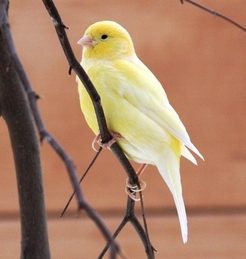Mapping of the canary genome

Canary song is regulated by hormones. © MPI f. Ornithology/ S. Seltmann
Nature lovers are fascinated by the increasing number of singing birds when spring is approaching. Scientists also take advantage of this seasonal phenomenon because they are able to investigate the underlying mechanism, however the evolutionary and molecularbiological background is largely unknown.
A team of researchers from the Max Planck Institute for Ornithology in Seewiesen and from the Max Planck Institute for Molecular Genetics in Berlin have now identified the genome of the canary. With these data they were able to decipher the evolution of hormone-sensitive gene regulation in seasonal singing birds.
Canaries have been domesticated since the 15th century and are the descendants of the wild canary that lives on the Azores, Madeira and Canary Islands in the North Atlantic Ocean. Like their wild ancestors, domesticated canaries sing stereotyped songs under long-day (breeding) conditions and more variable songs under short-day (non-breeding) photoperiods.
The canary has become a preferred model to investigate the neurological changes affecting hormone-dependent song. This is because it has a pronounced reproductive season, with seasonal changes in song and steroid hormone concentrations, and a varying degree of brain plasticity between the breeding and the non-breeding season.
A team of researchers from the department of Behavioural Neurobiology around Manfred Gahr at the Max Planck Institute for Ornithology in Seewiesen and from the Sequencing Core Facility under guidance of Bernd Timmermann from the Max Planck Institute for Molecular Genetics in Berlin together with colleagues from Brazil and the UK now have studied how hormone-sensitive gene regulation has evolved in songbirds. The work resulted in the first high quality assembly and annotation of a female canary genome. In birds, females are the ‘heterogametic’ sex (ZW) and therefore the analysed genome sequence contained both types of sex chromosomes, says Heiner Kuhl from the Max Planck Institute for Molecular Genetics.
Whole genome alignments between the canary and already identified genomes throughout the bird taxa showed that on a global scale bird genomes are quite similar. However, differences appeared when comparisons were conducted on a finer scale. For example, at the level of the nucleotide there are considerable species differences, which can impact small genetic sequences, such as steroid hormone receptor binding sites. Such differences in these regions might lead to major differences in gene regulation, even between closely related species, says Carolina Frankl-Vilches from the Max Planck Institute for Ornithology.
Following this global analysis the scientists focused on gene networks that had three characteristics – were showing enrichment or under-representation in the expression profiles of the song control regions HVC and RA, showed seasonality, and were testosterone-sensitive. To verify whether the hormone-sensitive elements among these genes are specific for the canary, they also looked at the genes of the zebra finch because this species did not evolve hormone-sensitive song expression. Among all HVC expressed genes, including the seasonal and testosterone-induced gene pools, many were strictly canary-specific. These analyses reveal specific evolutionary changes in different parts of the song system that control seasonal singing behaviour.
Thus, in the canary, those genes that are sensitive for testosterone and estrogen, and are also involved in the rewiring of neurons, might be crucial for re-differentiation of the underlying neuronal substrate, such as HVC, leading to seasonal song patterning. The present study demonstrates the need for high-quality genome assembly to detect the evolution of genes in comparative studies, says the coordinator of the study, Manfred Gahr from the Max Planck Institute for Ornithology.
Contact Dr. Carolina Frankl-VilchesMax Planck Institute for Ornithology, Seewiesen
Phone: +49 8157 932-402 Email: frankl@orn.mpg.de Dr. Bernd Timmermann
Max Planck Institute for Molecular Genetics, Berlin
Phone: +49 30 84131-777 Email: timmerma@molgen.mpg.de Dr. Stefan Leitner
Max Planck Institute for Ornithology, Seewiesen
Phone: +49 8157 932-421 Fax: +49 8157 932-209 Email: leitner@orn.mpg.de
Original publication
Carolina Frankl-Vilches, Heiner Kuhl, Martin Werber, Sven Klages, Martin Kerick, Antje Bakker, Edivaldo de Oliveira, Christina Reusch, Floriana Capuano, Jakob Vowinckel, Stefan Leitner, Markus Ralser, Bernd Timmermann, Manfred Gahr
Using the canary genome to decipher the evolution of hormone-sensitive gene regulation in seasonal singing birds
Genome Biology, 3 February 2015
Media Contact
More Information:
http://www.mpg.de/8937193/canary-genomeAll latest news from the category: Life Sciences and Chemistry
Articles and reports from the Life Sciences and chemistry area deal with applied and basic research into modern biology, chemistry and human medicine.
Valuable information can be found on a range of life sciences fields including bacteriology, biochemistry, bionics, bioinformatics, biophysics, biotechnology, genetics, geobotany, human biology, marine biology, microbiology, molecular biology, cellular biology, zoology, bioinorganic chemistry, microchemistry and environmental chemistry.
Newest articles

Properties of new materials for microchips
… can now be measured well. Reseachers of Delft University of Technology demonstrated measuring performance properties of ultrathin silicon membranes. Making ever smaller and more powerful chips requires new ultrathin…

Floating solar’s potential
… to support sustainable development by addressing climate, water, and energy goals holistically. A new study published this week in Nature Energy raises the potential for floating solar photovoltaics (FPV)…

Skyrmions move at record speeds
… a step towards the computing of the future. An international research team led by scientists from the CNRS1 has discovered that the magnetic nanobubbles2 known as skyrmions can be…





















